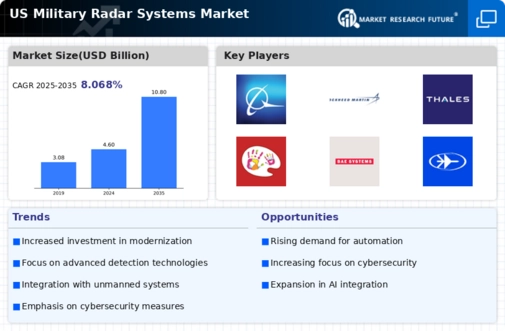The US Military Radar Systems Market is characterized by a highly competitive landscape that includes several prominent players, each contributing to technological advancements and strategic innovations. This market is driven by the increasing demand for advanced radar capabilities to enhance surveillance, reconnaissance, and target acquisition for various military applications. With the growing complexity of modern warfare, there is a continuous need for systems that can operate in contested environments and provide accurate tracking and detection of both aerial and ground threats.
This has prompted companies to invest in research and development, leading to the creation of cutting-edge radar technologies that cater to the specific requirements of the United States armed forces. Competitive dynamics within this market depict a landscape where collaborations, strategic partnerships, and government contracts play essential roles in determining market share and growth trajectories.Raytheon Technologies stands as a key player in the US Military Radar Systems Market, known for its robust portfolio of advanced radar solutions.
The company leverages its extensive experience in defense and aerospace to provide innovative radar systems that meet the diverse operational needs of the military. Raytheon Technologies excels in integrating advanced technologies such as artificial intelligence and machine learning into its radar systems, enhancing their effectiveness and operational efficiency. The company's strong presence in the market is underscored by its long-standing relationships with the US Department of Defense and various military branches, giving it access to critical contracts and funding for ongoing projects.
Additionally, the innovative capabilities offered by Raytheon Technologies have positioned it favorably in competitive bids, making it a vital contributor to national security initiatives. The commitment to advancing radar technology and maintaining high standards of performance solidifies its strengths in the industry.Boeing is another significant entity in the US Military Radar Systems Market, recognized for its comprehensive array of radar solutions tailored for military applications. The company provides key products such as ground-based surveillance radar, airborne radar systems, and other advanced sensing technologies that improve situational awareness for armed forces.
Boeing's strengths lie in its ability to harness its aerospace expertise and innovative engineering to develop radar systems that can operate in challenging environments. Over recent years, Boeing has further strengthened its market position through strategic mergers and acquisitions, expanding its capabilities and resource base in radar technology. The company's collaboration with defense organizations ensures that it remains engaged with evolving military requirements, while its investment in new technologies underlines its commitment to delivering state-of-the-art solutions.
With a solid foothold in the US defense ecosystem, Boeing continues to play a pivotal role in advancing military radar systems that are crucial for mission success.






















Leave a Comment